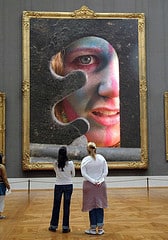This is part 2 in a two-part series. In my last post, I shared how I wrote a full-length three-act play in three days.
How did I do that? I was able to visualize my end product before sitting down to write.
As writers, we’re often groping in the dark, grasping for meaning as we work. When that happens, writing can be an act of discovery.
But great writing starts with purpose. Why? Because the writing process goes far beyond the act of capturing ideas and pinning them to paper with our words.
Writing is only half of the process.
Writing is a closed-circuit activity
Just as the play isn’t complete until it’s performed, your writing isn’t done until it connects with your reader.
Finding readers isn’t enough. Your words and ideas must connect. You don’t write for yourself. You write for your readers.
In Zen in the Art of Writing, Ray Bradbury says, “It is a lie to write in such a way as to be rewarded by money in the commercial market.”
I disagree.
If my writing does well in the commercial market, I know I’ve connected with my readers. And that, my friend, is the point of writing.
Granted, I’m taking Bradbury’s words out of context, but I’m doing it on purpose. He wants us to understand how writing for money or recognition will stunt our creativity. My point is that creativity can sometimes be a selfish pursuit.
Again, you must write for your reader, not yourself.
You must connect with your reader
Any writer who wants to luxuriate in the artist’s life and force everyone to accept her work on her terms isn’t being fair. It’s the same for any business that believes it’s acceptable to ram lackluster marketing and advertising down our throats.
We live in a busy world. Your readers are bombarded with 400,000 plus messages a day. Even those of us who love to read don’t have time for it. The magazines I subscribe to sit in a stack beside my reading chair, waiting for me to slow down long enough to glance — not read, but glance — at the pages.
If your reader does stop long enough to read your words, he should be rewarded with excellent, relevant, meaningful messaging. It should benefit him and his life.
Visualization is the key
Here’s my point: If you want your reader to “get” your message, you’ve got to write in such a way that it creates pictures in his mind. You can’t do that until you can visualize it yourself.
Writing a great sentence can be so rewarding, we forget the writing process isn’t about being a wordsmith. It’s about connecting with your target audience. And you’re much more likely to do that if you can visualize your message up front, before you sit down to write.
How do you visualize a message before it’s written?
Sometimes we don’t.
Granted, we all work differently. I know a writer who crafts the entire message in her head before she can write any of it down. There’s no way I could write long copy if I worked like that.
I need to start with my concluding point. Then I jot down the points that will lead to that conclusion. Once I have a rough outline, I’ll start at the top and write to the end.
Like Mark Twain, though, I may not know exactly what I’m saying until I’m most, if not all of the way, through the project. After I’ve put words on paper, I can see clearly what I’m trying to say and how my logic flows. Ideas often remain fuzzy around the edges until I’ve written something — anything.
After I’ve written my first draft, I can see clearly what I want to say. Then, like a sculptor, I must pull the ideas out of the words, cutting out anything that isn’t part of the big idea and smoothing out the rough edges.
Sometimes I’ll have started with one message and ended with another. It’s worth cutting my project in two and fleshing them out as two separate pieces. Other times, I can tweak it here or remove a section there to tighten my message.
That’s me. What about you?
How do you capture your vision for a writing project?
Share your ideas
Like Eudora Welty, do you enjoy knowing your destination before you write? Or do you wing it, watching the mystery of your ideas unfold as you go?
How do you ensure you flesh out your message without being shut down by writer’s block? Or like me, do you question the reality of writer’s block?
Share your comments below.
photo credit: shannonkringen


